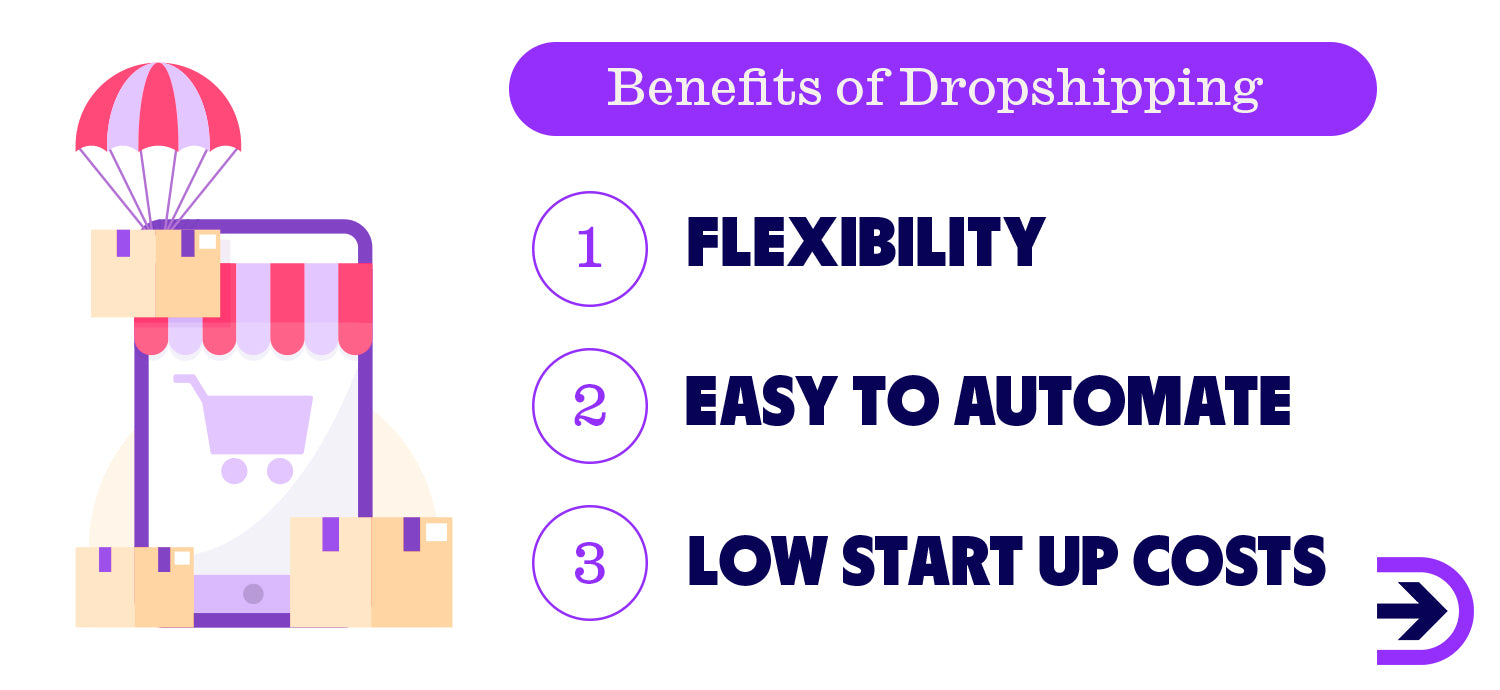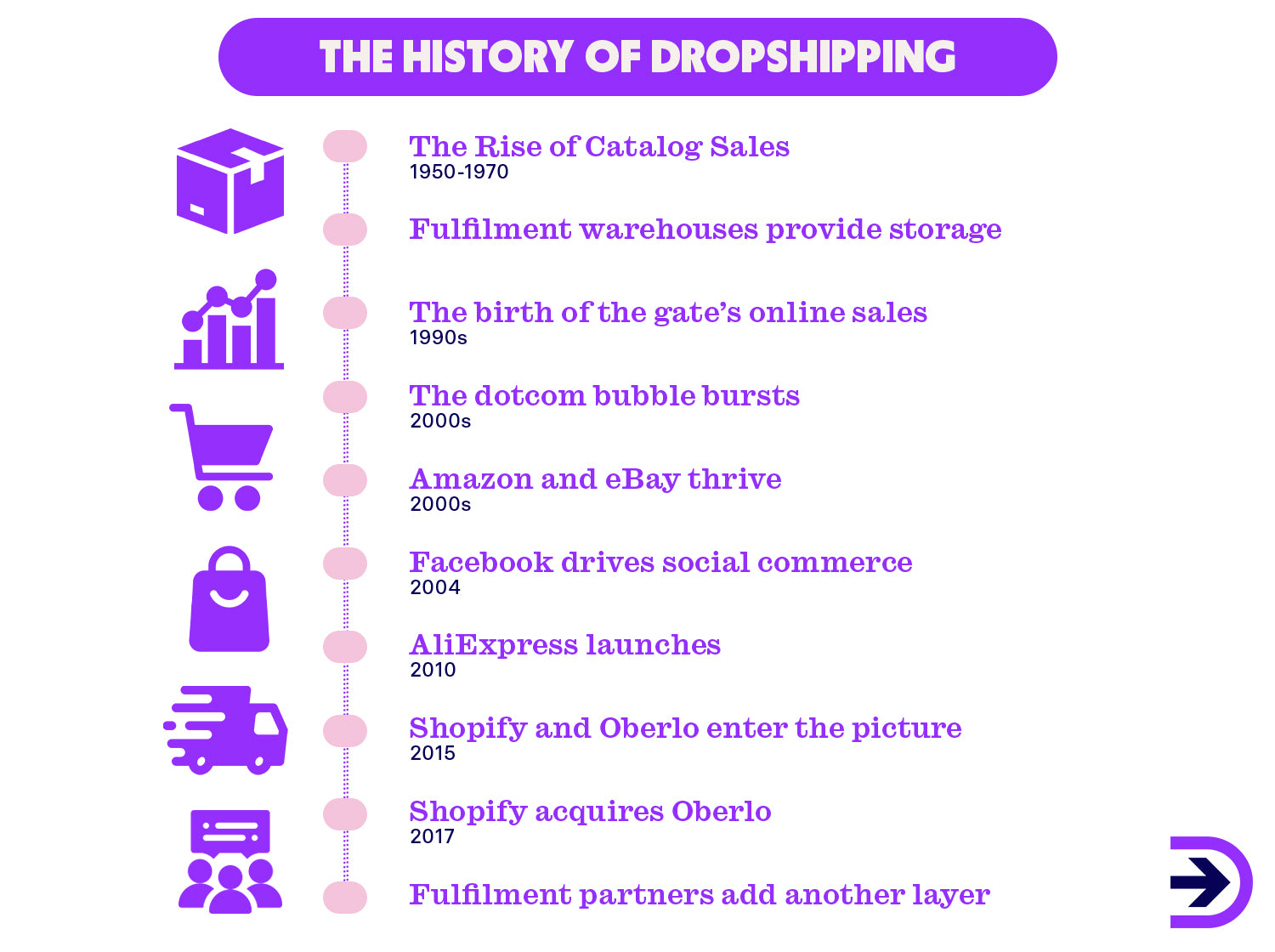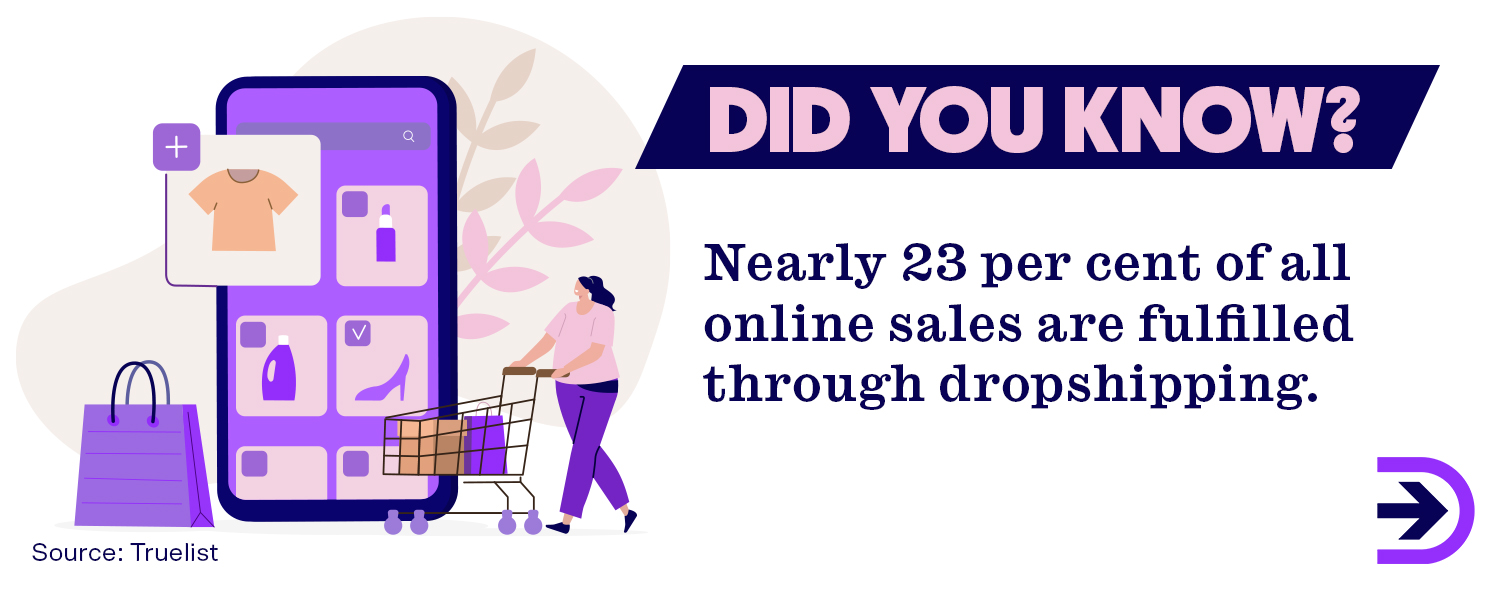
What is Dropshipping and How Does It All Work in 2025?
Looking to start your own business in 2025? Dropshipping is the ecommerce solution that everyone is talking about. It is a low risk, low cost solution that allows businesses around the world to deliver quality products without holding inventory. With a global market value of $351.8 billion as of 2024 and an expected market value of over $500 billion by 2026, there’s never been a better time to break into this booming industry.
If you are looking for a second income that doesn’t require a warehouse's worth of space, doesn’t have a ton of overhead costs, and offers flexibility, dropshipping might be an option for you. In this blog, we’ll explore what dropshipping is, how it benefits your business, and how you can get started with dropshipping in 2025.

What is dropshipping?
Dropshipping is an ecommerce fulfilment method where retailers never have to hold inventory or manage logistics. Instead, when a customer places an order with a dropshipping retailer, the retailer passes the order onto their dropshipping wholesaler or supplier. The supplier then ships the product directly to the end customer.
With dropshipping, the retailer essentially acts as a middleman between the consumer and a third-party supplier. Depending on the types of products sold, suppliers may be manufacturers, wholesalers, or other retailers. Retailers can even work with multiple suppliers.

How do dropshippers make money?
When dropshipping, retailers set their own product prices, putting you in control of your profit margins. When a customer makes an order, they pay the recommended retail price (RRP). When the retailer orders from their supplier, they pay a lower wholesale price and pocket the price difference.
For example: A retailer wants to break into the fashion market. They find a supplier that sells a popular t-shirt style for $20. The retailer adds the product to their store and sells it for $35. For every t-shirt ordered, the retailer pays their supplier $20 and pockets the $15 difference.
Unlike traditional retail, dropshipping retailers only buy stock from their suppliers as needed. Instead of investing hundreds of dollars in bulk stock, they only pay for stock that has already been sold. This means less upfront investment, less overall risk, and more profits.
The history of dropshipping
Dropshipping may be a recent buzzword, but the concept of dropshipping is not. Not only has dropshipping existed for decades, but some of your favourite big box retailers are already using it.
The concept of dropshipping has existed since the 1960s, with the birth of the mail order catalogue. Before ecommerce, this was one of the most popular fulfilment methods. Customers placed an order from the catalogue via phone and the order was delivered to their doorstep.
The popularity of the mail order catalogue led to empty shelves in stores. To account for this demand, fulfilment warehouses were created. These warehouses could store large volumes of stock to fill orders quickly and easily. The original ‘dropshippers’ saw these centres, filled to the brim with stock, and decided to offer these same products in their own catalogue, but with a slight mark-up. Customers were happy to shop for their favourite items from home, and this led to the first large-scale dropshipping companies.
The success of Amazon and eBay really highlighted to investors how profitable ecommerce could be. In the early days, most dropshippers relied on US-based suppliers. By the early 2000s, trade opened up and it became easier to source from overseas. In 2010, Aliexpress was launched, which made ordering products from Chinese manufacturers more accessible and affordable for both businesses and consumers. Between this and the advent of Shopify, creating your own online business became not only easy, but affordable.

There are plenty of well-known companies that either started as dropshippers or use dropshipping as a supplementary fulfilment method. Ikea, Kogan, Catch, Walmart and other stores with online marketplaces have used dropshipping in various capacities.
In 2021, Foot Locker announced that it was piloting a new dropshipping program in conjunction with Nike. This pilot program aimed to deliver more of the right product to the right customers in an appropriate time period, leading to fewer delays and more chances to restock on sold-out inventory. Major US department store Nordstrom also bought into dropshipping, and planned to reduce traditional wholesale offerings by up to 50 per cent while increasing concessions and dropshipping.
Benefits of dropshipping
Growing market value
Dropshipping as a business model has been growing exponentially over the past five years. This is largely due to the increase in online shopping and social commerce. In 2025, the market size is expected to pass $442.6 billion. The market is continuing to grow and shows no signs of stopping.

Lower risk
Dropshipping is a capital-light way of starting a business, where you can begin with minimal investment. This makes it much lower risk than other business models which require significant upfront capital. With dropshipping, you don’t have to buy inventory upfront, pay for warehousing, or pay shipping fees. This frees up additional capital and other resources that you can use to build your business and increase your return on investment.
Flexible business model
You can start a dropshipping business from anywhere in the world, at any time - all you need is an internet connection. Since most of your work will be done online, you can work from home, rent an office space, or share a coworking space. You don’t need a team of staff to run an online business - you can start alone and hire help as you go, or make use of the extensive automation tools available. Like with many small businesses, you get out of it what you put in. How you want to work is up to you.
Endless opportunities
There are endless numbers of suppliers, products and platforms awaiting dropshipping entrepreneurs. You can sell on platforms like eBay or Amazon, build your own website through Shopify, WordPress, Wix or Squarespace, and connect with hundreds of dropshipping suppliers ready to ship products. Your biggest hurdle will be choosing exactly what and where to sell.
Challenges of dropshipping
Standing out from the competition
One of the most attractive aspects of dropshipping is that it has very low overhead costs compared to other businesses. However, these low overhead costs aren’t just attractive to you, but to many other entrepreneurs. Not only that, but it’s rare to have exclusive deals with suppliers, meaning your competition can approach them and sell your exact same products.
This can be overcome by developing a detailed marketing plan before you start trading. It’s no longer enough to sell a good product at an affordable price – you will need to cover social media presence, content marketing, SEO, and paid advertising. You will also need to invest in your website to make sure it’s visually appealing and ticks all the boxes for good UX design. It may initially take time while you get used to your systems and grow your following, but the payoff will be a dedicated customer base who is happy to recommend your business to their friends, family, and influencers.
The public view of dropshipping and scammers
Scammers may be attracted to dropshipping due to the low start-up costs, which can create a reputational problem for others using dropshipping. Many dubious operators and practices come and go in the dropshipping space, including the following:
-
Selling a product that is not as described.
-
Advertising the business as an ‘independent boutique’ or ‘handmade store’ when the product is outsourced.
-
Selling the product as ‘free – just pay shipping’.
-
Scam dropshipping seminars that promise to teach you how to run your own business, but fail to deliver.
-
Suppliers that demand unreasonable, additional fees.
-
Suppliers selling products they are not allowed to – licensed products or products that are only illegal in certain countries.
These fraudsters can damage dropshipping’s image and, by extension, dropshippers.
Several high-profile cases like this may have caused damage to the dropshipping model. However, as more trusted retailers such as Foot Locker and Nordstrom give their stamp of approval and engage in dropshipping, we’re starting to see better business practices trickle down into online retailers using dropshipping at a smaller scale.
In terms of how to overcome these challenges, your brand strategy, including your social media presence and content marketing, will be your greatest asset. Post regularly and with an authentic voice, and make sure you respond to messages, comments and reviews in a timely manner. You’ll also want to invest in good customer service, whether this means investing in software or hiring extra team members. Ultimately, you want people to feel that they are talking to a real person and that their concerns are being heard.
Shipping delays
Because many dropshipping suppliers are based overseas, shipping delays are a consistent obstacle. Unfortunately, customers have come to expect a certain standard of service when it comes to delivery. While customer’s overall patience for delivery has increased, same day delivery has become a minimum expectation, and over 60 per cent of customers globally are willing to pay for the service (though only 9 per cent of retailers offer it).
Because dropshipping retailers rely on suppliers to meet delivery demands, it can be difficult to meet these expectations. The keys to a successful shopping strategy are transparency and reliability. The best way to provide a solid shipping experience is to work with your suppliers and maintain clear communication. Test the process yourself by ordering from your supplier. You may also want to consider offering free shipping or charging a flat fee rate. If there are delays, contact the customer and respond to their requests as soon as possible. Your customer might not mind long shipping times if they save money and you’re transparent about the process, but delays almost always cause frustration, and nipping it in the bud will prevent bad reviews and refunds. For more information, check out our comprehensive shipping strategy guide.
Returns and refunds
Dealing with returns and refunds is painful, especially if the refund is requested while the object is still in transit. Too many returns will hurt your business both financially and in reputation. There are all sorts of things you’ll have to consider such as restocking fees, whether the item is defective, and how you can come to a resolution in the shortest time. Regardless of whether the issue is with the supplier, the carrier, or natural disasters, the responsibility falls on you as the store owner to resolve your customer’s complaints.
When dropshipping and dealing with the challenges of returns and refunds, there are certain measures you can take to keep your customers satisfied. If the product is defective, you should always offer to pay for the return shipping. There’s nothing that will make a customer angrier than feeling like they’re being punished for someone else’s mistake. Many carriers give the option of sending prepaid shipping labels, so that’s an easy solution. It may be even easier to just send out a new product and let the customer keep the original – this is an ideal solution for small, inexpensive products that would cost more to ship back than to simply replace.

Requirements to start dropshipping
Investment
Although dropshipping requires lower overhead costs, but you still need a small amount of capital to begin. Some of the initial costs may include:
-
Product and shipping testing.
-
Web domain costs.
-
Cost of business name registration.
-
Legal or accounting fees if you wish to use consultants.
-
Paid advertising to grow your brand name early.
Here are some things that you shouldn’t pay for:
-
‘Additional’ supplier fees (while supplier directories may have monthly or annual fees, your suppliers should not charge you a ‘subscription’ or exclusivity).
-
Your ABN.
-
Followers or email lists.
ABN
An Australian Business Number (ABN) is an 11-digit number that identifies your business for tax purposes. For businesses with an annual turnover of $75,000, an ABN is compulsory. If you aren’t earning over that amount, you should still have an ABN. It’s free to apply for, and most reliable dropship suppliers won’t work with you unless you have an ABN. For more details, check out our guide about registering for an ABN for dropshipping purposes in Australia.
A dropshipping agreement
A dropshipping agreement is a contract between a seller and manufacturer/supplier that outlines respective rights and responsibilities. In your dropshipping agreement, you should include information such as:
-
Agreed price for goods.
-
Return policies.
-
Shipping terms.
A website and domain
Of course, an online business needs a website, and that website will need to be hosted by a platform or service provider. Unless you are a designer or IT professional yourself, you may also need to pay someone to build your website and act as tech support.
Luckily for you, there are plenty of easy ways to make a website. There are a variety of platforms such as Shopify, WordPress and Squarespace that make it easy to build a website affordably and will also cover hosting and support.
Terms of sale and privacy policies
There are many important documents that you will need to start your business. Two very important ones are your terms of sale (or sales terms and conditions), and your privacy policy.
Your terms of sale outline the buying process and the rights and responsibilities of both your and your customers. Key features of a terms of sale document would be:
-
How a customer can purchase your product.
-
How payment is collected.
-
What currencies are accepted.
-
How a customer can track the order’s process.
-
How or why your business might accept/reject an order.
-
Where the product is delivered from and estimated delivery times.
-
Cancellations, returns, refunds and exchanges.
Your privacy policy outlines how your business will handle your customer’s personal information. While not all businesses are legally required to have a privacy policy, it is recommended that you do. If you’re not sure your business is legally required to have a privacy policy, you can use the Privacy Checklist for Small Businesses.
Australian Consumer Law
In Australia, when you buy most products or services you are entitled to certain guarantees, as set out under Australian Consumer Law and enforced by the Australian Competition and Consumer Commission (ACCC). These guarantees include expectations of reasonable quality and safety from products, as well as warranty protection. The ACL also prohibits misleading or unfair sales tactics, contract terms or business practices.
ACL consumer guarantees apply regardless of your own policies. For instance, even if your business states ‘no refunds’, a consumer may still be entitled to a refund if the product is faulty, not of acceptable quality, or not as advertised.
Before starting a business, you should have a basic knowledge of ACL and how it applies to your products. You can get started with these resources from the ACL website.
How to get started dropshipping
-
Perform market research. What kind of audience are you looking to target? What products are trending right now?
-
Choose a niche you’re interested in. Nothing can tank a business faster than your lack of interest. If you don’t know or care about the product, you won’t be good at selling it.
-
Look for reliable suppliers. Thankfully, there are plenty of databases available to find your perfect dropshipping supplier. Consider their prices, fulfilment processes, and whether their products on offer are a good fit for your brand.
-
Do your due diligence. Make sure you have all the legal documents and details you need for a business, such as an ABN and registered business name. Additionally, each sales platform has it’s own policies and procedures regarding dropshipping. Make sure your desired platform supports dropshipping before opening your online store.
-
Choose trending products. Add popular and trending products to your store. Create winning product pages to attract potential buyers.
-
Optimise your website. Make sure your website is easy to navigate, easy to use, and provides a seamless shopping experience. Research current SEO practices to ensure your website is reaching the right audience through search engines. Consider providing multiple payment options to eliminate barriers to purchasing.
-
Start marketing your business. SEO and SEM will help you reach organic traffic, but you may also want to consider paid advertising using Google Ads, Meta Ads, or other tools. You may consider an omnichannel marketing strategy to target multiple audiences across platforms, or you can niche down and stick to the most popular platforms for your unique audience. It’s important that you meet your audience where they are, whether it’s on TikTok or through email marketing.

Start your dropshipping journey with Dropshipzone
Dropshipzone is your turnkey ecommerce solution.
If you’re looking to start dropshipping in Australia, look no further than Dropshipzone. As a B2B2C marketplace, our service comes with benefits that other platforms don’t offer.
-
Our marketplace has Australia-based service teams to offer prompt and personalised support.
-
Our suppliers have warehouses across Australia and the globe. More local deliveries = less supply chain disruptions, faster delivery, and better customer satisfaction.
-
Sign up is free - we don’t charge any upfront costs, subscription fees, or other hidden costs. Once your account is created, you’ll gain instant access to our full product catalogue, so you can start adding products to your store ASAP.
-
With competitive wholesale pricing and regular promotions, you’ll always find the perfect deal.
We take the stress out of dropshipping with our expertise and instant access to a wide range of products. We even offer in-app Shopify support. So, what are you waiting for? Get started on your dropshipping journey today with Dropshipzone.

